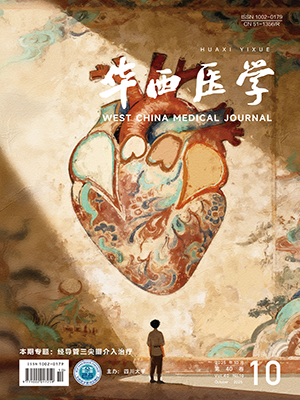| 1. |
中华人民共和国国家统计局. 第七次全国人口普查公报(第五号). (2021-05-11)[2022-08-29]. http://www.stats.gov.cn/tjsj/tjgb/rkpcgb/qgrkpcgb/202106/t20210628_1818824.html.
|
| 2. |
钟长征. 三部门发布第四次中国城乡老年人生活状况抽样调查成果. 中国社会工作, 2016(29): 6.
|
| 3. |
邱恒, 许军, 刘倩, 等. 广州市城镇老年人健康体适能水平及影响因素研究. 现代预防医学, 2022, 49(3): 476-481.
|
| 4. |
Wu ZJ, Wang ZY, Gao HE, et al. Impact of high-intensity interval training on cardiorespiratory fitness, body composition, physical fitness, and metabolic parameters in older adults: a meta-analysis of randomized controlled trials. Exp Gerontol, 2021, 150: 111345.
|
| 5. |
Chaabene H, Prieske O, Herz M, et al. Home-based exercise programmes improve physical fitness of healthy older adults: a PRISMA-compliant systematic review and meta-analysis with relevance for COVID-19. Ageing Res Rev, 2021, 67: 101265.
|
| 6. |
许浩, 邵慧秋, 黄晖明, 等. 有氧运动和力量训练对中老年人体适能的影响. 体育与科学, 2009, 30(3): 63-70.
|
| 7. |
Lai X, Bo L, Zhu H, et al. Effects of lower limb resistance exercise on muscle strength, physical fitness, and metabolism in pre-frail elderly patients: a randomized controlled trial. BMC Geriatr, 2021, 21(1): 447.
|
| 8. |
Schutzer KA, Graves BS. Barriers and motivations to exercise in older adults. Prev Med, 2004, 39(5): 1056-1061.
|
| 9. |
Dinyer TK, Byrd MT, Garver MJ, et al. Low-Load vs. high-load resistance training to failure on one repetition maximum strength and body composition in untrained women. J Strength Cond Res, 2019, 33(7): 1737-1744.
|
| 10. |
Hawkins S, Wiswell R. Rate and mechanism of maximal oxygen consumption decline with aging: implications for exercise training. Sports Med, 2003, 33(12): 877-888.
|
| 11. |
Ortega FB, Cadenas-Sanchez C, Lee DC, et al. Fitness and fatness as health markers through the lifespan: an overview of current knowledge. Prog Prev Med (N Y), 2018, 3(2): e0013.
|
| 12. |
Sui X, LaMonte MJ, Laditka JN, et al. Cardiorespiratory fitness and adiposity as mortality predictors in older adults. JAMA, 2007, 298(21): 2507-2516.
|
| 13. |
Navarrete-Villanueva D, Gómez-Cabello A, Marín-Puyalto J, et al. Frailty and physical fitness in elderly people: a systematic review and meta-analysis. Sports Med, 2021, 51(1): 143-160.
|
| 14. |
Rubenstein LZ. Falls in older people: epidemiology, risk factors and strategies for prevention. Age Ageing, 2006, 35(Suppl 2): ii37-ii41.
|
| 15. |
Bohannon RW. Hand-grip dynamometry predicts future outcomes in aging adults. J Geriatr Phys Ther, 2008, 31(1): 3-10.
|
| 16. |
Ruiz JR, Sui X, Lobelo F, et al. Association between muscular strength and mortality in men: prospective cohort study. BMJ, 2008, 337(7661): a439.
|
| 17. |
王光旭, 王兴, 陈新丽, 等. 抗阻训练对老年人骨密度影响的 meta 分析. 上海体育学院学报, 2019, 43(5): 67-76.
|
| 18. |
Westcott WL. Resistance training is medicine: effects of strength training on health. Curr Sports Med Rep, 2012, 11(4): 209-216.
|
| 19. |
Hurley BF, Hanson ED, Sheaff AK. Strength training as a countermeasure to aging muscle and chronic disease. Sports Med, 2011, 41(4): 289-306.
|
| 20. |
Izquierdo M, Merchant RA, Morley JE, et al. International exercise recommendations in older adults (ICFSR): expert consensus guidelines. J Nutr Health Aging, 2021, 25(7): 824-853.
|
| 21. |
林红, 习玉宝, 於辉. 用近红外组织血氧参数无损监测仪进行运动人体研究. 光谱学与光谱分析, 2014, 34(6): 1538-1541.
|
| 22. |
Wilkinson TJ, White AEM, Nixon DGD, et al. Characterising skeletal muscle haemoglobin saturation during exercise using near-infrared spectroscopy in chronic kidney disease. Clin Exp Nephrol, 2019, 23(1): 32-42.
|
| 23. |
陈力全, 李悠, 任彦军, 等. 结构性健身运动对老年人体适能的影响. 中国老年学杂志, 2020, 40(5): 1007-1009.
|
| 24. |
杨鸣, 黄志成, 吴佳妮, 等. 水中运动对老年人体成分、健康体适能、生活质量的影响. 中国老年学杂志, 2019, 39(24): 6012-6014.
|




